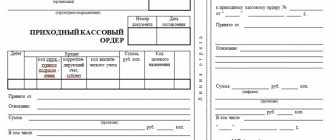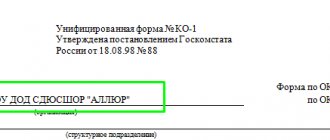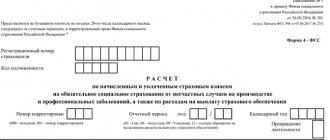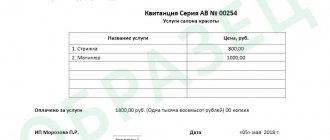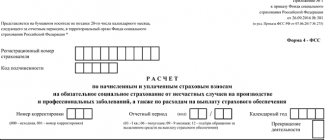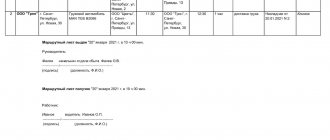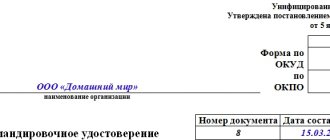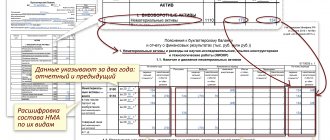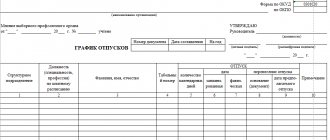The standard intersectoral Form M-4 - Receipt Order and Instructions for its use and completion were approved by Resolution of the State Statistics Committee of the Russian Federation dated October 30, 1997 N 71a “On approval of unified forms of primary accounting documentation for accounting of labor and its payment, fixed assets and intangible assets, low-value materials and wearable items, work in capital construction.” In the article we will talk about the receipt order (form M-4), and consider the procedure for filling it out.
Used for materials accounting. These may include materials received from suppliers and materials received from recycling. You can also issue a receipt order for materials accepted for safekeeping. Applicable to all organizations, regardless of their field of activity.
The materially responsible person draws up the Receipt Order directly upon receipt of inventories (MPS) to the warehouse. Received valuables are recalculated, their quantity is compared with the quantity reflected in the supplier’s documents and is submitted for reporting to the financially responsible person. To formalize such a transfer, a Receipt Order is drawn up in Form M-4.
Who issues the receipt order?
Since the direct receipt of incoming goods takes place at the warehouse, the document is filled out by a warehouse employee - the storekeeper or his boss, i.e. financially responsible person. A receipt order is a documentary confirmation of the fact of transfer of inventory items from one party to the contract to the other.
- Form and sample
- Free download
- Online viewing
- Expert tested
FILES
2021 sample
This year, the form of the document has not changed at all compared to the previous year. An order in form M-4 is drawn up as shown in the figure:
- The document number is written (in the center).
- Then - the full name of the organization, as well as the structural unit.
- The corresponding OKPO code is written in the right corner.
- In the first table, all columns are filled in - date of arrival, code, warehouse number, information about the supplier and insurance company, the corresponding account, as well as the numbers of the accompanying and payment documents.
- The main table indicates all the data about the arrived product - name, how many pieces, amount with and without VAT, total amount.
- All empty lines are crossed out.
A detailed explanation of all columns is presented in the table.
| column name | filling rules |
| name of the company or structural unit | The full name of the company or individual entrepreneur at whose disposal the relevant goods or raw materials for production was received is indicated. It is important to indicate the name in full, as it appears in official documents, for example Limited Liability Company “Proxy” or Individual Entrepreneur Alexander Pavlovich Bondarenko. |
In the structural unit column we mean the internal department of the enterprise. Usually it is written as “warehouse”.
If precious metals and/or products made from them are being accepted, column 11 is also filled out in the table, which indicates the number of the technical passport for each unit of goods.
The form and example of a completed receipt order are presented below.
NOTE. The accountant is not required to print out the receipt order. It’s enough to simply compose it in the 1C program. You can do without a paper form of the document if acceptance and posting are formalized on the invoice or invoice of the supplier of the goods. A stamp is placed and its details are filled in, which are considered an analogue of the receipt.
Basic rules for filling out form M-4
Since 2013, this form has not been strictly mandatory for use, however, it is still widely used in enterprises and organizations.
The receipt order has two sides and contains all the necessary information regarding the supplier, consumer and the product itself: its name, grade, size, quantity, cost, etc. (it should be noted that some cells can be left empty). If the inventory contains precious metals or stones, then this document must indicate information from the accompanying technical passport.
When filling out an order, you should avoid mistakes and omissions, and if there are any inaccuracies, it is better to fill out a new form.
According to the rules, the form can be filled out either by hand or on a computer, but in any case, the document must necessarily contain “live” signatures of the supplier’s representative and the consumer.
After registration, the number of the receipt order must be registered in the materials accounting card and transferred for storage to the accounting department of the enterprise, where it, like other primary documents, must be stored for at least five years.
The document is issued exactly on the day the goods are received and reflects the actual receipt. A receipt order is drawn up in one copy, and if there are several deliveries from the same supplier within one day, they can all be entered into one document.
How to automate work with documents and avoid filling out forms manually
Automatic filling of document forms. Save your time. Get rid of mistakes.
Connect to CLASS365 and take advantage of the full range of features:
- Automatically fill out current standard document forms
- Print documents with signature and seal image
- Create letterheads with your logo and details
- Create the best commercial offers (including using your own templates)
- Upload documents in Excel, PDF, CSV formats
- Send documents by email directly from the system
- Keep track of goods in your store for free
With CLASS365 you can not only automatically prepare documents. The free warehouse accounting program CLASS365 allows you to manage an entire company in one system, from any device connected to the Internet. It is easy to organize effective work with clients, partners and staff, maintain trade records, warehouse records using bar codes and financial records. CLASS365 automates the entire enterprise.
Instructions for filling out a receipt order
It is impossible to say that this type of document may cause any difficulties when filling out, since it has a completely simple and understandable form. The standard receipt order form can be divided into several parts, which contain three tables.
Filling out the “header” and first table of form M-4
The first table is the “header” of the document. First, it indicates the order number for the company’s internal document flow. Then enter the name of the organization receiving the goods, indicating its legal form (IP, LLC, OJSC, CJSC), the OKPO code (All-Russian Classifier of Enterprises named after Organizations - the code is contained in the constituent papers of the company), as well as (if necessary) the structural unit , which issues the order.
Next, the table includes the date the document was compiled, the transaction type code (if such coding is used), the supplier’s warehouse number, its full name, code (if any) and the insurer (if the inventory items are insured). Then the accounting account numbers, analytical accounting code (if such a system is used), and the numbers of the accompanying and payment documents are indicated here.
Filling out the second table of form M-4
The second table of the receipt order relates directly to incoming products . First, the name of the product and its item number are indicated, then the unit of measurement: its code - in accordance with the Unified Classifier of Units of Measurement, and the name (pieces, kilograms, cubes, meters, etc.). Next, information is entered on the number of accepted inventory items (according to documents and actually) - they must match.
After this comes information about the cost: in the seventh column the price per piece is entered, then the total cost excluding VAT, then the allocated VAT, and then the total price including VAT. The passport number is indicated if inventory items have this accompanying document (for example, jewelry). Lastly, the card number according to the warehouse card index is entered into the table.
The remaining unfilled lines must be crossed out (in the form of the letter Z or crosswise).
Filling out the reverse side of the M-4 form
The reverse side of the document summarizes the receipt : the total quantity of goods received, its total cost excluding VAT, the amount of VAT and the cost including VAT. There is no need to decipher the amounts in writing.
Finally, the receipt order must be signed by the direct recipient of the goods (in this case, the storekeeper) and the supplier’s representative (in this case, the forwarder) with a mandatory decoding. There is no need to certify the order with a seal, because from 2021, legal entities may not have their documents stamped.
Related documents
- Promissory note (solo)
- Payment order (sample)
- Payment request
- Payment request-order
- Account cash warrant. Form No. ko-2
- Account cash warrant. Form No. ko-2
- Request for release of materials. Form No. m-11
- Form of a bill of exchange with a period of so much time upon presentation and with a dated inscription of acceptance (approved by Letter of the Central Bank of the Russian Federation dated September 9, 1991 No. 14-3-30)
- Form of a bill of exchange with a period of so much time upon presentation and with a dated inscription of acceptance (approved by Letter of the Central Bank of the Russian Federation dated September 9, 1991 No. 14-3-30)
- Form of a bill of exchange for a certain day, indicating the year, month and day and a non-negotiable personal endorsement (approved by Letter of the Central Bank of the Russian Federation dated September 9, 1991 No. 14-3-30)
- Form of a promissory note for a certain date and a guarantee inscription to a credit institution (approved by Letter of the Central Bank of the Russian Federation dated September 9, 1991 No. 14-3-30)
- Form of a promissory note for a period of so much time upon presentation (approved by Letter of the Central Bank of the Russian Federation dated September 9, 1991 No. 14-3-30)
- Form of a promissory note for a certain day and a non-recourse blank endorsement (approved by Letter of the Central Bank of the Russian Federation dated September 9, 1991 No. 14-3-30)
- Form of a promissory note for a certain day, indicating the year, month and date and a personal endorsement (approved by Letter of the Central Bank of the Russian Federation dated September 9, 1991 No. 14-3-30)
- Check card
- Sample of filling out a payment order for transferring funds to the deposit account of the arbitration court
- Sample payment order for payment of arrears of insurance contributions for compulsory pension insurance
- Invoice form for payment
- Balance sheet (form 1) (OKUD 0710001)
- Cash flow statement (form 4) (OKUD 0710004)
Purpose
Issued to confirm all transactions related to the receipt of goods from the supplier, as well as materials subsequently used for the production of products. In accounting, it is determined that it is the receipt order that represents the main document, which reflects the fact of acceptance of goods for subsequent warehouse accounting.
At the same time, a receipt is issued in all cases when they receive:
- the actual product,
- raw materials for production processes,
- semi-finished products for further sale and/or use in production, as well as food preparation.
Along with this appointment, the receiver plays a big role in the case of registering goods for storage in a warehouse. It is on the basis of the data in this document that a material storage record card is compiled (form M-17 is approved by law).
Moreover, if goods or raw materials, technical materials are purchased, which will later be used for production purposes, then the receipt order is the only primary reporting document that confirms the fact of receipt.
Registration deadlines
There are cases of large volume deliveries of goods during the day. The legislation allows you to draw up one receipt document, and enter all goods into it as they are received until the end of the working day. However, these must be homogeneous goods (for example, raw materials or semi-finished products of a certain group).
NOTE. The order is issued only on the day the goods or raw materials arrive. Accordingly, it must be drawn up upon receipt before the end of working hours.
Thus, an order must be drawn up only in the event of further use of goods and raw materials for the production of new products . And if the company is engaged in their sale, then it is enough to simply use the invoices for the goods and affix the organization’s stamp.
Penalties for lack of PCO
The absence or improper execution of primary cash documents, which, in particular, include a cash receipt order, may result in penalties for the taxpayer in accordance with Art. 120 of the Tax Code of the Russian Federation.
So, according to this article, a gross violation of the rules for accounting for income and (or) expenses and (or) objects of taxation, if these acts were committed during one tax period, in the absence of signs of a tax offense, entails a fine of ten thousand rubles.
At the same time, a gross violation of the rules for accounting for income and expenses and taxable items means the absence of primary documents, including primary cash documents.
Also, the absence of primary cash documents from the purchasing organization may become the basis for the refusal of the tax authority to recognize the specified expenses of the organization for the purposes of taxation of profits or a single tax in accordance with the simplified taxation system (the object of taxation is income reduced by the amount of expenses incurred).
Actions of the cashier after receiving funds
After this, the cashier accepts the money and, after receiving it, puts his signature, surname and initials on the receipt order and receipt.
On the receipt, the cashier also indicates the date the money was received and certifies his signature with a seal. The receipt is stamped so that the edge overlaps the receipt order itself
After the money arrives at the cash register, the cashier tears off the receipt for the PKO along the cut line and hands it to the person who handed over the money, and leaves the cash order at the cash register.
